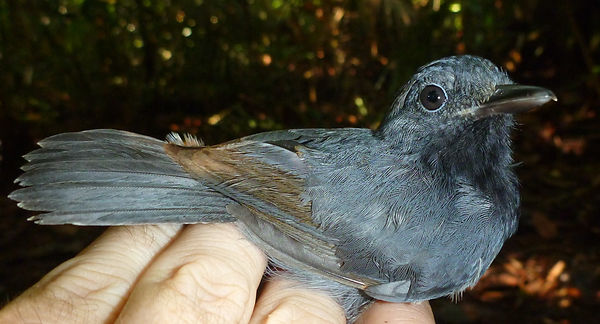
Wolfe Laboratory
Michigan Technological University
Black-throated Antshrike (Thamnomanes ardesiacus) commonly forages on arthropods with mixed-species flocks in lowland evergreen forests in South America. Sexes are distinguishable early in life where males are veiled gray with a black throat, and females are brownish overall. The preformative molt (FPF) is partial, and definitive prebasic molts (DPBs) are complete. FPF includes less coverts, med coverts, and some greater coverts.

Thamnomanes ardesiacus

FCJ - First Cycle Juvenile
First cycle juvenile (FCJ ) individuals characterized by a single generation of loosely textured plumage, often edged brown. Tail feathers noticeably more tapered than definitive cycle basic (DCB) individuals.

FPF - First PreFormative
First preformative (FPF) molt is partial, where loosely-textured juvenal body feathers and some flight feather coverts are replaced with uniformly gray (male) or brown (female) plumage. Because the preformative molt occurs immediately after the acquiring the juvenal plumage early in a birds life, the retained juvenal flight feathers appear fresh (although somewhat tapered relative to DCB individuals).

FCF - First Cycle Formative
FCF - First Cycle Formative
First cycle formative (FCF ) individuals have retained juvenal primary coverts, several outer greater coverts (sometimes they replace all greater coverts during the preformative molt), remiges (variable number of tertials) and rectrices. The partial nature of the preformative molt results in noticeable molt limits (more obvious in males where dark-gray formative plumage contrasts with brownish-gray juvenal plumage). Above, molt limits are found in the greater coverts (outer two are retained) and between primary coverts (all retained) and replaced inner greater coverts.

SPB - Second PreBasic
Second prebasic (SPB) molt is complete where remigial replacement begins at P1 (as well as in the tertials) and proceeds distally; inner-secondary replacement begins at S1 (when primary molt reaches P4, P5, or P6) and proceeds proximally. SPB birds are interesting because they represent the only age class with three generations of plumage (juvenal, formative, and second/definitive basic). Identifying juvenal plumage in addition to symmetrical flight feather molt is the key to ageing birds as SPB. It becomes difficult to distinguish SPB from later prebasic molts in the latter stages of completing the second prebasic molt due to the few remaining juvenal feathers; in these difficult cases, you can age these birds as definitive prebasic (DPB).

DCB - Definitive Cycle Basic
Definitive cycle basic (DCB) is characterized by a uniform and single generation of plumage: slate gray in males and brown in females.

DPB - Definitive PreBasic
Definitive prebasic (DPB) individuals are undergoing complete molts (i.e. symmetrically replacing flight feathers). Technically, SPB individuals can be classified as DPB because they are undergoing their first definitive prebasic molt. It is important to remember that when birds are undergoing complete molts, identification of "old" or retained plumage as either juvenal or definitive basic is used to separate SPB from DPB individuals.